Montana is home to a diverse array of avian species, ranging from songbirds to raptors. One of the most striking species in the region is the black and white bird.
With its contrasting pattern of dark feathers on its back and wings and white plumage on its belly and throat, this bird is unmistakable in appearance.
Found across Montana’s vast wilderness areas and forests, this species is a common sight for birdwatchers and nature enthusiasts alike. Join us as we take a closer look at this unique and beautiful feathered friend.
1. American Goldfinch
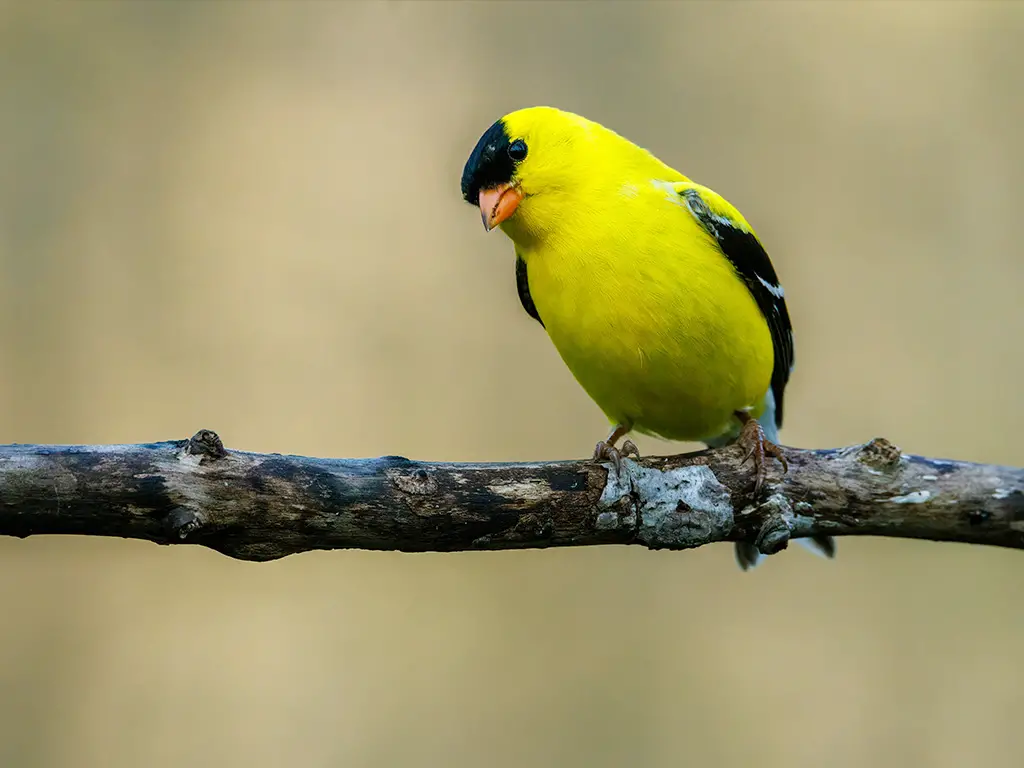
The American goldfinch is a small North American bird in the finch family. Males are vibrant yellow with black wings and tail, while females are duller in colouration.
It migrates from mid-Alberta to North Carolina during breeding season, south of Canada–United States border to Mexico for its wintering grounds.
The only finch which undergoes complete molt every year, it displays sexual dichromatism where males have brighter colours than their female counterparts.
They feed mainly on seeds but also eat insects such as aphids and caterpillars when raising youngs; they often occur near thistles or other plants that produce viable seed heads.
Their call consists of an array of chirps and trills making them quite conspicuous.
Scientific classification:
| Kingdom | Animalia |
| Phylum | Chordata |
| Class | Aves |
| Order | Passeriformes |
| Family | Fringillidae |
| Subfamily | Carduelinae |
| Genus | Spinus |
| Species | S. tristis |
Also Featured In: Most Common United States Birds, Most Common Winter Birds
2. Black-Capped Chickadee

The black-capped chickadee is a small and cheerful songbird found in deciduous and mixed forests across North America. It has an iconic black cap, white cheeks, gray back and wings with whitish bars on them.
The underparts are usually light colored or greyish brown. This species is well adapted to cold winters as it can reduce its body temperature by up to 8°C while roosting at night; this helps save energy during the colder months of the year.
It feeds mainly on insects but also eats seeds, fruits and suet from bird feeders when available.
Black-capped chickadees are popular birds among backyard visitors due to their sociable nature – they often establish lifelong partnerships with one another for breeding purposes.
Furthermore, they have been designated as state birds of Massachusetts and Maine in USA plus New Brunswick in Canada – a testament to how beloved these little avian friends truly are.
Scientific classification:
| Kingdom | Animalia |
| Phylum | Chordata |
| Class | Aves |
| Order | Passeriformes |
| Family | Paridae |
| Genus | Poecile |
| Species | P. atricapillus |
Also Featured In: Most Common Songs Birds that Live around You, Birds Commonly Found in New York
3. White-Breasted Nuthatch

The White-breasted Nuthatch is a medium-sized bird belonging to the nuthatch family Sittidae. It measures around 15.5 cm in length and its colour varies throughout its range.
Males have a light blue-grey upperpart, with black crown and nape whereas females have a dark grey crown instead of black one.
The underparts are whitish, with reddish tinge on sides and flanks while the bill is short and stout with pale base near eyes which can be yellow or white depending upon geographic location..
This species feeds mainly on insects but will also eat seeds, nuts and berries when available.
They prefer open woodlands where they often climb trees searching for food along trunks as well as branches underneath bark crevices creating their nest there too.
Scientific classification:
| Kingdom | Animalia |
| Phylum | Chordata |
| Class | Aves |
| Order | Passeriformes |
| Family | Sittidae |
| Genus | Sitta |
| Species | S. carolinensis |
Also Featured In: Blue Birds You’ll Found around Us, Birds Live in Arkansas
4. Black-Necked Stilt
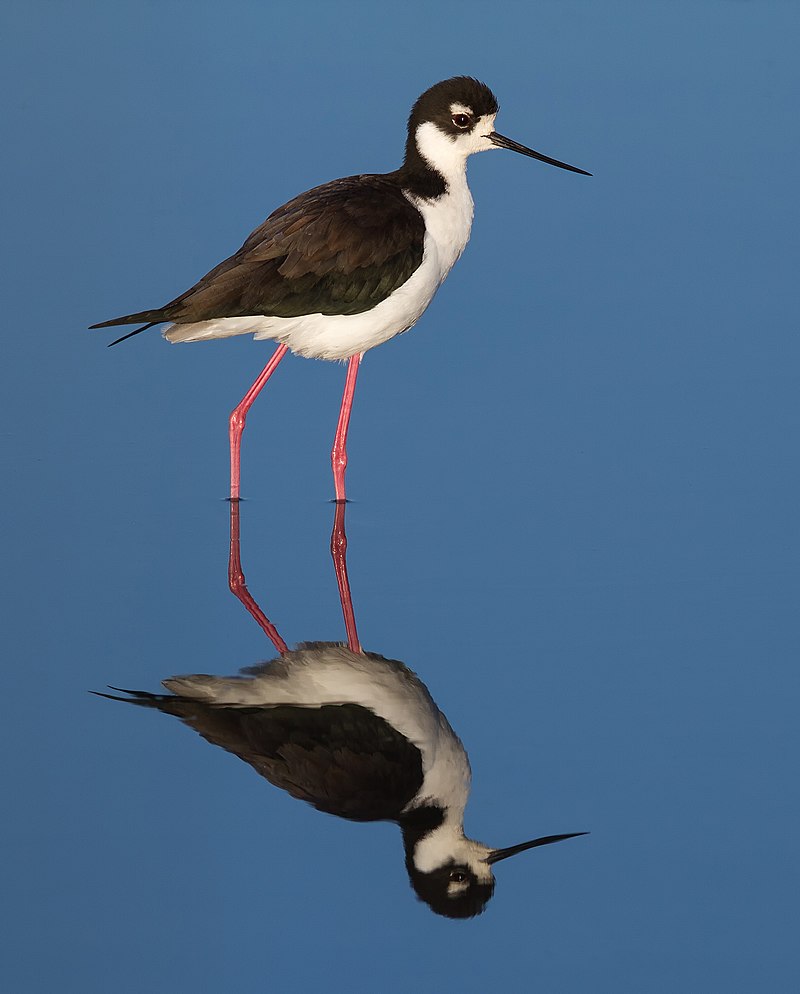
The Black-necked Stilt is an elegant shorebird that can be found from the coastal areas of California to Florida, then south through Central America and Brazil.
It has black upperparts contrasted by long white wings with a glossy sheen. Its striking red eyes are set against its white facial mask while its legs are bright pinkish in coloration.
The Haematopus mexicanus species inhabits marshy wetlands and brackish lagoons where it feeds on insects, crustaceans, small amphibians and fish which they catch using their slender bill or chase after them as they run across the surface of water or mudflats.
This bird typically nests near shallow waters but will use any habitat type if food resources are available nearby making it a highly adaptable species well suited for human altered habitats such as rice fields and sewage ponds.
Scientific classification:
| Kingdom | Animalia |
| Phylum | Chordata |
| Class | Aves |
| Order | Charadriiformes |
| Family | Recurvirostridae |
| Genus | Himantopus |
| Species | H. mexicanus |
Also Featured In: Beautiful Brazilian Birds, Phoenix Birds You Should Know
5. Loggerhead Shrike
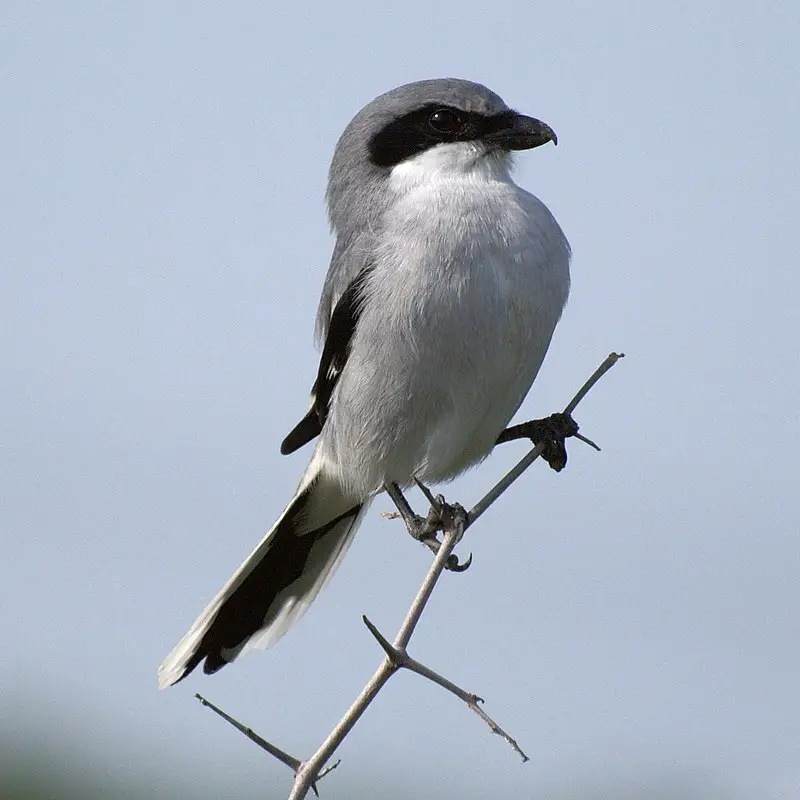
The Loggerhead Shrike is a carnivorous bird found only in North America. It belongs to the family Laniidae and is known as the “butcherbird” because of its habit of catching prey, such as amphibians, insects, lizards and small mammals.
The shrike has a black mask around its eyes and grey wings with white patches on them.
Its back is black with white spots that resemble stars or snowflakes; some individuals may have brown feathers instead of black ones.
This species feeds mainly by perching from elevated locations like bushes or trees where it can spot potential meals below it before diving down for capture.
Interestingly enough, these birds are also known to store their food by impaling it onto thorns which they use later when hungry.
With less than 2 million estimated population left in wild today this species needs our help so we should do whatever we can to protect them better.
Scientific classification:
| Kingdom | Animalia |
| Phylum | Chordata |
| Class | Aves |
| Order | Passeriformes |
| Family | Laniidae |
| Genus | Lanius |
| Species | L. ludovicianus |
Also Featured In: Top Birds Found in Mexico, Common Birds in Alberta
6. Common Goldeneye
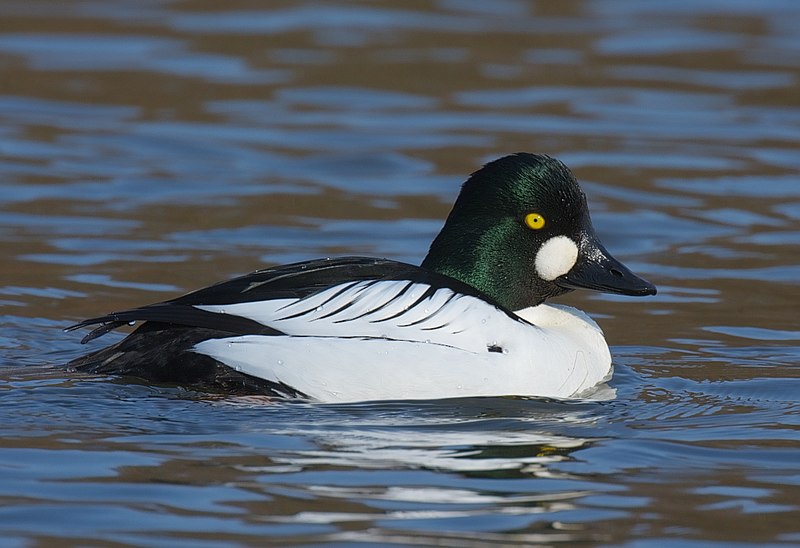
The Common Goldeneye is a medium-sized sea duck from the genus Bucephala. It has an iconic golden eye and bulbous head, which gave it its scientific name – Boukephalos (bullheaded).
This species can be found in many areas of North America, Europe and Asia. They are usually seen swimming alone or in pairs near large bodies of open water such as lakes and rivers.
In addition to their distinctive eyes, they have white wing patches on either side with black spots along the edges – helping them stand out among other ducks.
The diet of these birds includes aquatic insects, mollusks and crustaceans.
During mating season males often perform elaborate courtship displays including head bobbing while producing loud calls that can travel quite far distances across the landscape.
Scientific classification:
| Kingdom | Animalia |
| Phylum | Chordata |
| Class | Aves |
| Order | Anseriformes |
| Family | Anatidae |
| Genus | Bucephala |
| Species | B. clangula |
Also Featured In: Birds of Poland, Acadia National Park Birds
7. Ring-Billed Gull
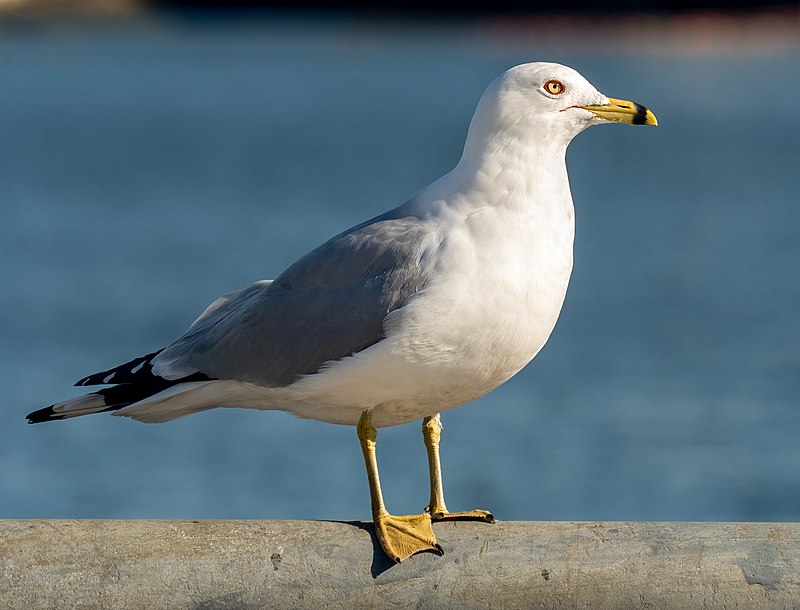
The Ring-billed Gull is a medium sized seabird that can be seen throughout North America. Its head, neck and underparts are white while its back and wings are silver gray in color.
It has a relatively short yellow bill with a dark ring around it, as well as yellow legs.
The genus name for this species of gull comes from the Latin word ‘Larus’ which referred to large sea birds or gulls; while the specific delawarensis refers to the Delaware River where these birds were first discovered.
These beautiful creatures thrive near coasts, lakeshores and other bodies of water but also have been known to inhabit urban areas such as parks close by those watersides due to their adaptability towards human habitats.
Scientific classification:
| Kingdom | Animalia |
| Phylum | Chordata |
| Class | Aves |
| Order | Charadriiformes |
| Family | Laridae |
| Genus | Larus |
| Species | L. delawarensis |
Also Featured In: Gulls Species, Birds Live Near San Diego
8. Black-And-White Warbler
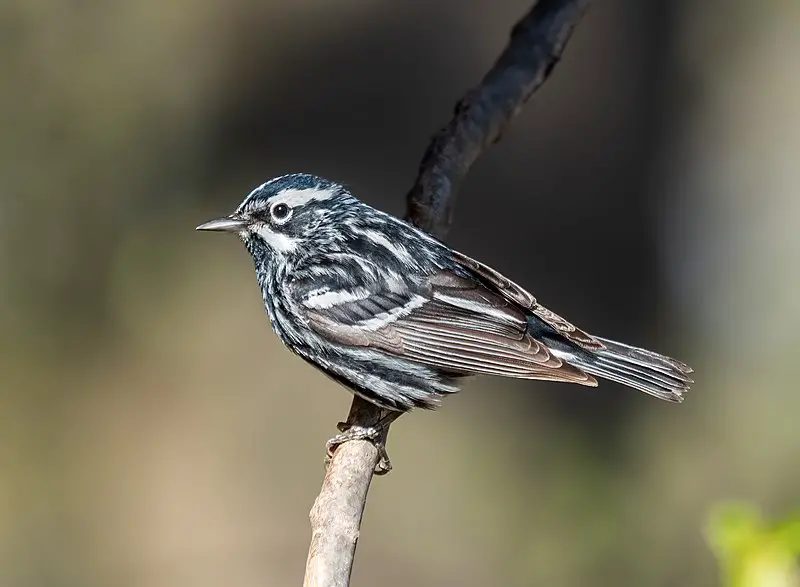
The Black-and-white Warbler is a unique species of bird native to North America. It has striking black and white plumage and breeds in the northern part of the continent, wintering in Central America, Florida, West Indies and Peru.
This warbler is rarely seen as far west as Europe but it’s still being studied for its behavior and ecology.
Its diet consists mainly of insects which it catches by clinging on trees like a woodpecker before quickly darting away again when prey appears.
The population size remains stable although they are vulnerable to habitat loss due to deforestation or other human activities so their conservation status should be monitored closely over time.
Scientific classification:
| Kingdom | Animalia |
| Phylum | Chordata |
| Class | Aves |
| Order | Passeriformes |
| Family | Parulidae |
| Genus | Mniotilta Vieillot, 1816 |
| Species | M. varia |
Also Featured In: Nuthatches Species, Long Island Birds You Should Know
9. Lark Bunting
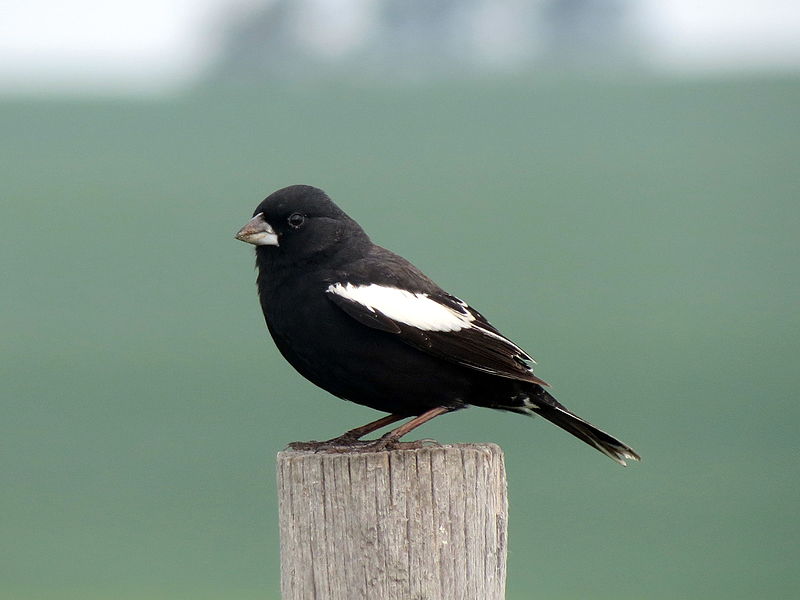
The Lark Bunting is a medium-sized sparrow native to central and western North America. It was designated the state bird of Colorado in 1931, making it an important part of local culture.
The species is monotypic; meaning it’s not related to any other genera out there.
J.K Townsend first described this fascinating bird back in 1837 after finding a specimen during his travels with Major Stephen H Long on their expedition up the Platte River valley through Nebraska and Wyoming into South Dakota.
This friendly little creature has black feathers at its crown, grey wings and tail, white breast streaked with black patches – all contributing together to create one colorful picture.
Its habitat ranges from grasslands across prairies as well as cultivated farms where they usually nest low down on ground level or within shrubs for safety purposes.
With such beautiful features along with its cheerful chirps that can be heard throughout springtime mornings, no wonder why this majestic avian holds so many admirers amongst nature lovers everywhere.
Scientific classification:
| Kingdom | Animalia |
| Phylum | Chordata |
| Class | Aves |
| Order | Passeriformes |
| Family | Passerellidae |
| Genus | Calamospiza Bonaparte, 1838 |
| Species | C. melanocorys |
Also Featured In: Sparrows Species, Birds That Live in Colorado
10. Black-Billed Magpie
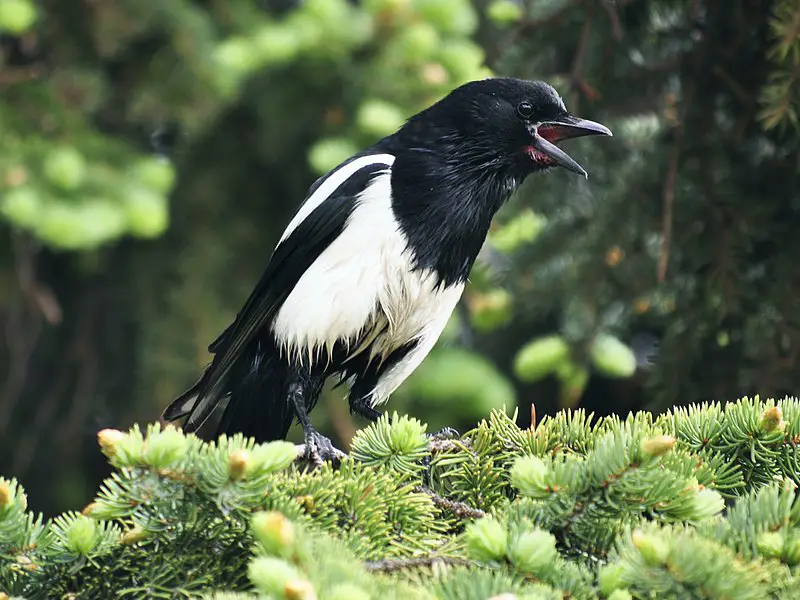
The black-billed magpie is an iconic bird of the western half of North America and one of only four songbirds with a tail that makes up over half its body length.
With its glossy black feathers offset by white patches, they can be seen in open woodlands or near agricultural areas.
Their diet consists mainly of insects, carrion and grains but they often scavenge human food as well.
They are highly social birds who live in large groups and communicate through loud calls, snaps and rattles when defending their territory from other airborne predators like hawks or eagles.
Magpies have proven to be hardy survivors despite habitat loss due to urbanization so there’s hope these remarkable birds will remain part our landscape for many years to come.
Scientific classification:
| Kingdom | Animalia |
| Phylum | Chordata |
| Class | Aves |
| Order | Passeriformes |
| Family | Corvidae |
| Genus | Pica |
| Species | P. hudsonia |
Also Featured In: Utah Birds, Birds that Found in the Yellowstone
11. Bullock’s Oriole
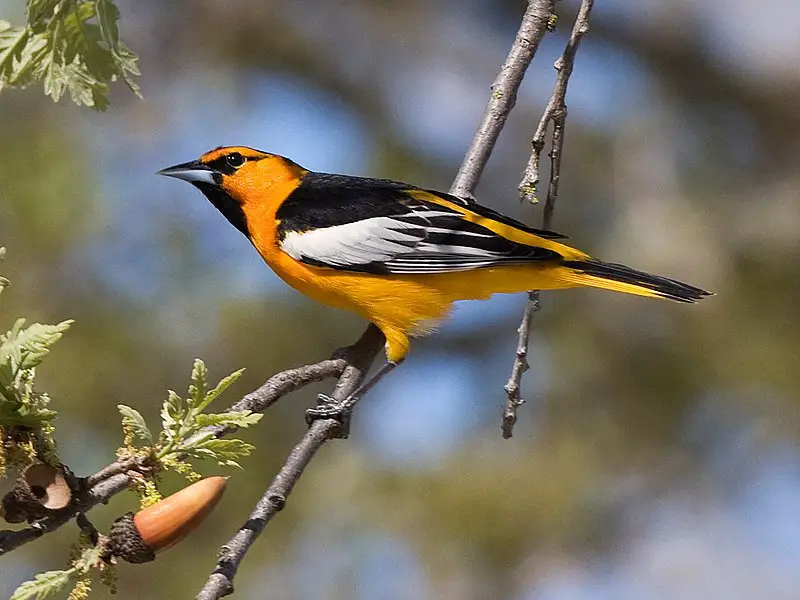
Bullock’s oriole is a small, sexually dimorphic New World blackbird that was once thought to be the same species as Baltimore Oriole. It was named after William Bullock, an English amateur naturalist.
Male birds are more brightly colored and slightly larger than females. These birds typically have yellow heads and wings with dark brown or black bodies with white bars on their backs and tails.
They can often been seen perched high up in trees foraging for insects among foliage or singing from branches during mating season.
Their diet consists of mostly fruits such as oranges, apples, plums; they also eat some seeds like millet along with grasshoppers and other insects when available.
The Bullock’s oriole is found throughout western North America in areas of woodland scrubland which provide it shelter from predators while providing plenty food sources to sustain itself year round.
Scientific classification:
| Kingdom | Animalia |
| Phylum | Chordata |
| Class | Aves |
| Order | Passeriformes |
| Family | Icteridae |
| Genus | Icterus |
| Species | I. bullockii |
Also Featured In: Common Yellow Birds of Idaho, Yellow Georgia Birds
12. Blackpoll Warbler
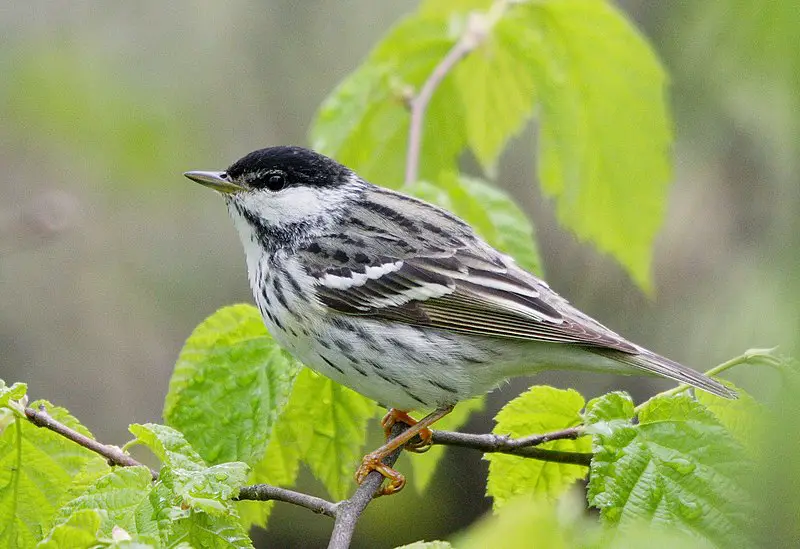
The Blackpoll Warbler is an impressive and beautiful bird. It has a black cap, white cheeks and white wing bars.
During the breeding season it can be found in forests of northern North America from Alaska through Canada to the mountains of New York and New England.
In fall they migrate south, sometimes travelling over 3,000 miles non-stop – one record was set for 75 hours.
They are very adaptable birds but their numbers have been declining due to habitat destruction so conservation efforts must remain ongoing if we want these amazing creatures around forevermore.
Scientific classification:
| Kingdom | Animalia |
| Phylum | Chordata |
| Class | Aves |
| Order | Passeriformes |
| Family | Parulidae |
| Genus | Setophaga |
| Species | S. striata |
Also Featured In: Pennsylvania Birds, Black And White Birds You Don’t Know About
13. Bufflehead
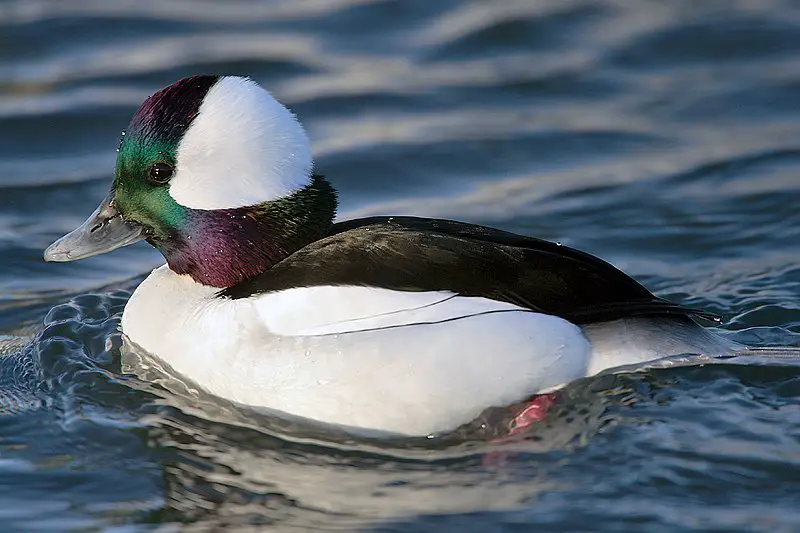
The Bufflehead bird is a small sea duck belonging to the goldeneyes genus. It was first described in 1758 by Carl Linnaeus, and its scientific name is Bucephala albeola.
The name “Bucephala” comes from the Greek words for “bull-headed,” which refers to its oddly shaped, bulbous head.
These birds are known for their striking black and white plumage, with the males sporting distinctive iridescent green and purple feathers on their heads.
Buffleheads are found primarily in North America, spending their winters on coastal waters and migrating inland to breed in wooded areas.
They are skilled divers and feed primarily on insects and small crustaceans. Despite their small size, Buffleheads are hardy birds and can survive in extreme weather conditions.
Scientific classification:
| Kingdom | Animalia |
| Phylum | Chordata |
| Class | Aves |
| Order | Anseriformes |
| Family | Anatidae |
| Genus | Bucephala |
| Species | B. albeola |
Also Featured In: Water Birds Live around Us, Estuaries Birds